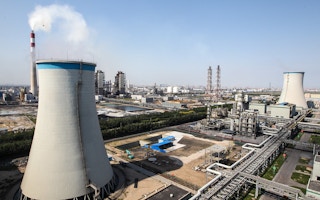Capturing planet-warming gases and storing them below ground is a key part of many plans to keep climate change in check - but very little progress has been made on it, scientists, industry officials and environmentalists warn.
In Europe, capacity to store carbon dioxide - sucked from power plants, industries or straight from the air - is only a thousandth of what is needed, said Andrew Cavanagh, an emissions storage researcher at Scotland’s University of Edinburgh.
And very little of the “extraordinarily large amounts of storage” likely to be needed is even in development, he added.
“We’re so far off trend it makes you wonder what we’re doing,” he told a conference in the English city of Oxford this week on efforts to rapidly slash emissions.
Bjorn Haugstad, head of climate, industry and technology at Norway’s energy ministry, agreed that plans for “carbon capture and storage” (CCS) seemed both “inevitable but impossible”.
“We are struggling with making a good business case for CCS,” he admitted.
That is a problem as countries across the region - including Britain - set increasingly ambitious goals to virtually eliminate their heat-trapping emissions in coming decades.
Britain in June pledged to target “net zero” emissions by 2050, with former Prime Minister Theresa May saying current generations had a “moral duty to leave this world in a better condition than what we inherited”.
“
We are struggling with making a good business case for CCS.
Bjorn Haugstad, head of climate, industry and technology, Ministry of Energy, Norway
The country is pouring 26 million pounds ($32 million) into carbon capture projects in a bid to spur technology officials see as key to meeting the new climate goal.
Around the world, such projects would either put captured carbon dioxide into long-term storage below the Earth’s surface or deep in oceans - or try to turn the emissions into products such as fuels, chemicals or aggregate needed for concrete.
Damage management?
The International Energy Agency expects 7 per cent of emissions reductions needed by 2040 will come from such plants, as the world struggles to slash its emissions by a challenging 45 per cent by 2030 to meet Paris Agreement climate goals.
But without an effective system in place to charge those who produce emissions for the cost of cleaning them up - as “carbon pricing” remains limited - such technologies are struggling to take off commercially in Europe, experts said at the conference.
“We’re stuck in a waiting game, where everybody agrees somebody should take responsibility” but no one is stepping up, Norway’s Haugstad said.
Changing that may require governments to absorb more of the cost of researching, developing and deploying the technology, said David Hawkins, director of climate policy for the Natural Resources Defense Council, an environmental group.
Governments could offer tax breaks or, more controversially, demand that fuel producers, for instance, use the technology to remove a small share of the emissions they create in an effort to drive it forward, Hawkins said.
CCS remains controversial - some fossil fuel firms see it as a way to keep pumping, and environmentalists fear it could slow a transition to clean power. But it “needs to be in the toolbox” to cut excess emissions if climate threats surge, Hawkins said.
With the Bahamas slammed by a devastating hurricane and fires, heatwaves and other disasters claiming more lives, “climate suffering is here now”, he noted.
Nick Eyre of the UK Centre for Research into Energy Demand Solutions said reducing emissions - not trying to capture them - was still the best way to curb climate risk.
“Why would you want to do something difficult and expensive if you can do something cheap and easy?” he asked.
Hawkins said CCS technologies should be considered primarily as a “damage management technique” - similar to car seatbelts and airbags - as the world rushes to avert a climate crash.
“If we didn’t have them, we could face a worse death toll,” he said.
This story was published with permission from Thomson Reuters Foundation, the charitable arm of Thomson Reuters, that covers humanitarian news, climate change, resilience, women’s rights, trafficking and property rights. Visit http://news.trust.org/climate.










